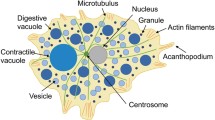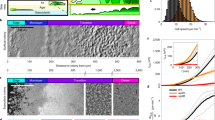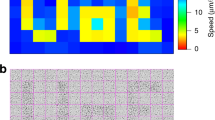Abstract
Some invasive pathogens and other particles are propelled intracellularly by the polymerization of actin at the particle surface into a dense “comet tail” of filamentous actin. As new monomers are added to the filament (+)-ends located the junction between the particle and its comet tail, the particle is propelled forward. The molecular origin of force generation and how the elongating comet tail remains attached to the particle surface via nucleation promoting factors such as N-WASP remain unresolved questions. Recently, based on measurements of biomimetic particles coated with RickA, a bacterial homolog to N-WASP, Shaevitz and Fletcher [Proc. Natl. Acad. Sci. U.S.A. 104:15688–15692, 2007] reported that particle speed depends on the separation distance from a nearby wall (slide surface), a result which they interpreted as the effect of hydrodynamic coupling to the wall damping fluctuations and inhibiting monomer addition, consistent with the well-known “Brownian ratchet” model for force generation. Based on a reaction-diffusion model for monomer transport and consumption at the particle surface, we show here that the experimentally observed speed-separation distance profile is completely consistent with hindered monomer diffusion due to the presence of the nearby wall. That is, the observed reduction in speed can be entirely explained by hindered diffusion, without invoking any hydrodynamic effect.





Similar content being viewed by others
References
Bernheim-Groswasser, A., J. Prost, C. Sykes. Mechanism of actin-based motility: a dynamic state diagram. Biophys J. 89:1411-1419. 2005.
Bernheim-Groswasser, A., S. Wiesner, R.M. Golsteyn, M.F. Carlier, C. Sykes. The dynamics of actin-based motility depend on surface parameters. Nature. 417:308-311. 2002.
Brebbia, C.A. 1984 Boundary Element Techniques. New York: Springer-Verlag. 1984.
Bugyi, B., C. Le Clainche, G. Romet-Lemonne, M. F. Carlier. How do in vitro reconstituted actin-based motility assays provide insight into in vivo behavior? FEBS Lett. 582(14):2086–2092, 2008.
Cameron, L.A., T.M. Svitkina, D. Vignjevic, J.A. Theriot, G.G. Borisy. Dendritic organization of actin comet tails. Curr Biol. 11:130-135. 2001.
Co, C., D.T. Wong, S. Gierke, V. Chang, J. Taunton. Mechanism of actin network attachment to moving membranes: barbed end capture by N-WASP WH2 domains. Cell. 128:901-913. 2007.
Dickinson, R.B. A multiscale model for actin-propelled bacteria. Cellular and Molecular Bioengineering. 1:110-121. 2008.
Dickinson, R.B. Models for actin polymerization motors. J Math Biol. 58:81-103. 2009.
Dickinson, R.B., L. Caro, D.L. Purich. Force generation by cytoskeletal filament end-tracking proteins. Biophys J. 87:2838-2854. 2004.
Dickinson, R.B., D.L. Purich. Clamped-filament elongation model for actin-based motors. Biophys J. 82:605-617. 2002.
Dickinson, R.B., D.L. Purich. Diffusion rate limitations in actin-based propulsion of hard and deformable particles. Biophys J. 91:1548-1563. 2006.
Gouin, E., C. Egile, P. Dehoux, V. Villiers, J. Adams, F. Gertler, R. Li, P. Cossart. The RickA protein of Rickettsia conorii activates the Arp2/3 complex. Nature. 427:457-461. 2004.
Hill, T.L. Microfilament or microtubule assembly or disassembly against a force. Proc Natl Acad Sci U S A. 78:5613-5617. 1981.
Lacayo, C.I., Z. Pincus, M.M. VanDuijn, C.A. Wilson, D.A. Fletcher, F.B. Gertler, A. Mogilner, J.A. Theriot. Emergence of large-scale cell morphology and movement from local actin filament growth dynamics. PLoS Biol. 5:e233. 2007.
McGrath, J.L., N.J. Eungdamrong, C.I. Fisher, F. Peng, L. Mahadevan, T.J. Mitchison, S.C. Kuo. The force-velocity relationship for the actin-based motility of Listeria monocytogenes. Curr Biol. 13:329-332. 2003.
McGrath, J.L., Y. Tardy, C.F. Dewey, Jr., J.J. Meister, J.H. Hartwig. Simultaneous measurements of actin filament turnover, filament fraction, and monomer diffusion in endothelial cells. Biophys J. 75:2070-2078. 1998.
Mogilner, A., G. Oster. Cell motility driven by actin polymerization. Biophys J. 71:3030-3045. 1996.
Mogilner, A., G. Oster. Force Generation by Actin Polymerization II: The Elastic Ratchet and Tethered Filaments. Biophys J. 84:1591-1605. 2003.
Noireaux, V., R.M. Golsteyn, E. Friederich, J. Prost, C. Antony, D. Louvard, C. Sykes. Growing an actin gel on spherical surfaces. Biophys J. 78:1643-1654. 2000.
Parekh, S.H., O. Chaudhuri, J.A. Theriot, D.A. Fletcher. Loading history determines the velocity of actin-network growth. Nat Cell Biol. 7:1119-1123. 2005.
Peskin, C.S., G.M. Odell, G.F. Oster. Cellular motions and thermal fluctuations: the Brownian ratchet. Biophys J. 65:316-324. 1993.
Plastino, J., I. Lelidis, J. Prost, C. Sykes. The effect of diffusion, depolymerization and nucleation promoting factors on actin gel growth. Eur Biophys J. 33:310-320. 2004.
Pollard, T.D., L. Blanchoin, R.D. Mullins. Molecular mechanisms controlling actin filament dynamics in nonmuscle cells. Annu Rev Biophys Biomol Struct. 29:545-576. 2000.
Samarin, S., S. Romero, C. Kocks, D. Didry, D. Pantaloni, M.F. Carlier. How VASP enhances actin-based motility. J Cell Biol. 163:131-142. 2003.
Sechi, A.S., J. Wehland, J.V. Small. The isolated comet tail pseudopodium of Listeria monocytogenes: a tail of two actin filament populations, long and axial and short and random. J Cell Biol. 137:155-167. 1997.
Shaevitz, J.W., D.A. Fletcher. Load fluctuations drive actin network growth. Proc Natl Acad Sci U S A. 104:15688-15692. 2007.
Soo, F.S., J.A. Theriot. Adhesion controls bacterial actin polymerization-based movement. Proc Natl Acad Sci U S A. 102:16233-16238. 2005.
Soo, F.S., J.A. Theriot. Large-scale quantitative analysis of sources of variation in the actin polymerzation-based movement of Listeria monocytogenes. Biophys J. 89:703-723. 2005.
Stevens, J.M., E.E. Galyov, M.P. Stevens. Actin-dependent movement of bacterial pathogens. Nat Rev Microbiol. 4:91-101. 2006.
Trichet, L., O. Campas, C. Sykes, J. Plastino. VASP governs actin dynamics by modulating filament anchoring. Biophys J. 92:1081-1089. 2007.
Upadhyaya, A., J.R. Chabot, A. Andreeva, A. Samadani, A. van Oudenaarden. Probing polymerization forces by using actin-propelled lipid vesicles. Proc Natl Acad Sci U S A. 100:4521-4526. 2003.
Wiesner, S., E. Helfer, D. Didry, G. Ducouret, F. Lafuma, M.F. Carlier, D. Pantaloni. A biomimetic motility assay provides insight into the mechanism of actin-based motility. J Cell Biol. 160:387-398. 2003.
Acknowledgment
This work was supported by a grant from the National Science Foundation (CTS-0505929).
Author information
Authors and Affiliations
Corresponding author
Rights and permissions
About this article
Cite this article
Dickinson, R.B. Diffusion-Limited Speed of an Actin-Propelled Particle Near a Surface. Cel. Mol. Bioeng. 2, 200–206 (2009). https://doi.org/10.1007/s12195-009-0056-8
Received:
Accepted:
Published:
Issue Date:
DOI: https://doi.org/10.1007/s12195-009-0056-8




